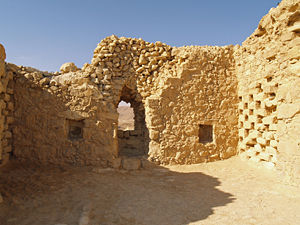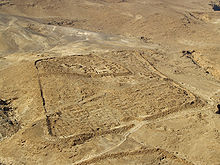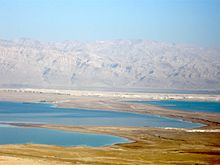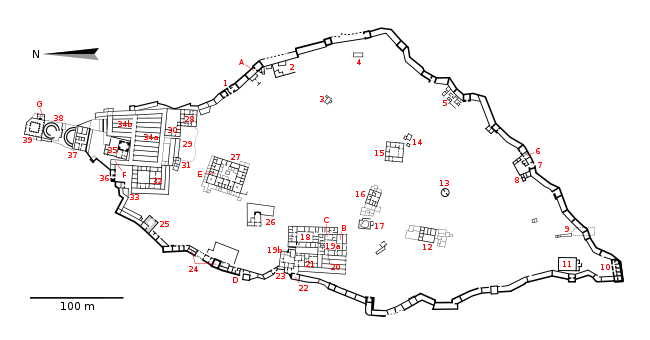- Masada
-
This article is about the Judean fortress. For other uses, see Masada (disambiguation).
Masada * UNESCO World Heritage Site
Dovecote at Masada, where ashes were probably stored—the openings have been shown to be too small for pigeons to fit.Country Israel Type Cultural Criteria iii, iv, vi Reference 1040 Region ** Europe and North America Inscription history Inscription 2001 (25th Session) * Name as inscribed on World Heritage List
** Region as classified by UNESCOMasada (Hebrew מצדה, pronounced
 Metzada (help·info), from מצודה, metzuda, "fortress") is the name for a site of ancient palaces and fortifications in the South District of Israel, on top of an isolated rock plateau, or horst, on the eastern edge of the Judean Desert, overlooking the Dead Sea. Masada is best known for the violence that occurred there in the first century CE. In the final accords of the First Jewish-Roman War, a Siege of Masada by troops of the Roman Empire led to the mass suicide of the Sicarii rebels. Masada is located about 20 kilometres (12 mi) east of Arad.
Metzada (help·info), from מצודה, metzuda, "fortress") is the name for a site of ancient palaces and fortifications in the South District of Israel, on top of an isolated rock plateau, or horst, on the eastern edge of the Judean Desert, overlooking the Dead Sea. Masada is best known for the violence that occurred there in the first century CE. In the final accords of the First Jewish-Roman War, a Siege of Masada by troops of the Roman Empire led to the mass suicide of the Sicarii rebels. Masada is located about 20 kilometres (12 mi) east of Arad.Contents
Geography
The cliffs on the east edge of Masada are about 1,300 feet (400 m) high and the cliffs on the west are about 300 feet (91 m) high; the natural approaches to the cliff top are very difficult. The top of the plateau is flat and rhomboid-shaped, about 1,800 feet (550 m) by 900 feet (270 m). There was a casemate wall around the top of the plateau totaling 4,300 feet (1.3 km) long and 12 feet (3.7 m), with many towers, and the fortress included storehouses, barracks, an armory, the palace, and cisterns that were refilled by rainwater. Three narrow, winding paths led from below up to fortified gates.
History
Further information: Siege of Masada Remnants of one of several legionary camps at Masada, just outside the circumvallation wall
Remnants of one of several legionary camps at Masada, just outside the circumvallation wall
According to Josephus, a 1st-century CE Jewish Roman historian, Herod the Great fortified Masada between 37 and 31 BCE as a refuge for himself in the event of a revolt. In 66 CE, at the beginning of the First Jewish-Roman War against the Roman Empire, a group of Jewish extremists, called the Sicarii, overcame the Roman garrison of Masada. After the destruction of the Second Temple in 70 CE, additional members of the Sicarii and numerous Jewish families fled Jerusalem and settled on the mountaintop, using it as a base for harassing the Romans.[1]
In 72, the Roman governor of Iudaea Lucius Flavius Silva headed the Roman legion X Fretensis and laid siege to Masada. The Roman legion surrounded Masada and built a circumvallation wall and then a siege embankment against the western face of the plateau, moving thousands of tons of stones and beaten earth to do so. Josephus does not record any attempts by the Sicarii to counterattack the besiegers during this process, a significant difference from his accounts of other sieges against Jewish fortresses. He did record their raid before the siege on Ein-Gedi, a nearby Jewish settlement, where the Sicarii allegedly killed 700 of its inhabitants.
According to Dan Gill,[2] geological investigations in the early 1990s confirmed earlier observations that the 375-foot (114 m) high assault ramp consisted mostly of a natural spur of bedrock that required a ramp only 30 feet (9.1 m) high built atop it in order to reach the Masada defenses. This discovery would diminish both the scope of the construction and of the conflict between the Sicarii and Romans, relative to the popular perspective in which the ramp was an epic feat of construction. The rampart was complete in the spring of 73, after probably two to three months of siege, allowing the Romans to finally breach the wall of the fortress with a battering ram on April 16.[3] According to Josephus, when Roman troops entered the fortress, they discovered that its 960 inhabitants had set all the buildings but the food storerooms ablaze and committed a mass suicide. Modern archaeologists have found no evidence of mass burial at the location and only some thirty skeletons have been recovered on the site.
Masada today
The site of Masada was identified in 1842 and extensively excavated between 1963 and 1965 by an expedition led by Israeli archeologist Yigael Yadin. While a hike up the Snake Path on the eastern side of the mountain (access via the Dead Sea Highway) is considered part of the "Masada experience," a cable car operates at the site for those who wish to avoid the physical exertion. Due to the remoteness from human habitation and its arid environment, the site has remained largely untouched by humans or nature during the past two millennia. The Roman ramp still stands on the western side and can be climbed on foot. Many of the ancient buildings have been restored from their remains, as have the wall-paintings of Herod's two main palaces, and the Roman-style bathhouses that he built. The synagogue, storehouses, and houses of the Jewish rebels have also been identified and restored. The meter-high circumvallation wall that the Romans built around Masada can be seen, together with eleven barracks for the Roman soldiers just outside this wall. Water cisterns two-thirds of the way up the cliff drain the nearby wadis by an elaborate system of channels, which explains how the rebels managed to have enough water for such a long time.
Inside the synagogue, an ostracon bearing the inscription me'aser cohen (tithe for the priest) was found, as were fragments of two scrolls; parts of Deuteronomy 33-34 and parts of Ezekiel 35-38 (including the vision of the "dry bones"), found hidden in pits dug under the floor of a small room built inside the synagogue. In other loci fragments were found of the books of Genesis, Leviticus, Psalms, and Sirach, as well as of the Songs of the Sabbath Sacrifice.
In the area in front of the northern palace, eleven small ostraca were recovered, each bearing a single name. One reads "ben Yair" and could be short for Eleazar ben Ya'ir, the commander of the fortress. It has been suggested that the other ten names are those of the men chosen by lot to kill the others and then themselves, as recounted by Josephus.
 View facing east from Masada. The Dead Sea and Lisan Peninsula are in the middle distance; Jordan is in the background.
View facing east from Masada. The Dead Sea and Lisan Peninsula are in the middle distance; Jordan is in the background.
Archaeologist Yigael Yadin's excavations uncovered the skeletal remains of 28 people at Masada. The remains of a male 20–22 years of age, a female 17-18 and a child approximately 12 years old, were found in the palace. The remains of two men and a full head of hair with braids belonging to a woman were also found in the bath house. Forensic analysis showed the hair had been cut from the woman's head with a sharp instrument while she was still alive (a Jewish practice for captured women) while the braids indicated she was married. Based on the evidence, anthropologist Joe Zias believes the remains may have been Romans whom the rebels captured when they seized the garrison.[4] The remains of 25 people were found in a cave at the base of the cliff. Carbon dating of textiles found with the remains in the cave indicate they are contemporaneous with the period of the Revolt and it is believed that as they were buried with pig bones (a Roman practice), this indicates the remains may belong to Romans who garrisoned Masada after its recapture. Others, nevertheless, still maintain that the remains are those of the Jewish Zealots who committed suicide during the siege of Masada, and all were reburied at Masada with full military honours on July 7, 1969.[5][6]
The remnants of a Byzantine church dating from the 5th and 6th centuries, have also been excavated on the top of Masada.
The Masada story was the inspiration for the "Masada plan" devised by the British during the Mandate era. The plan was to man defensive positions on Mount Carmel with Palmach fighters, in order to stop Erwin Rommel's expected drive through the region in 1942. The plan was abandoned following Rommel's defeat at El Alamein.[citation needed]
The Chief of Staff of the Israel Defence Forces (IDF), Moshe Dayan, initiated the practice of holding the swearing-in ceremony of soldiers who have completed their Tironut (IDF basic training) on top of Masada. The ceremony ends with the declaration: "Masada shall not fall again." The soldiers climb the Snake Path at night and are sworn in with torches lighting the background.[7]
Masada was declared a UNESCO World Heritage Site in 2001. An audio-visual light show is presented nightly on the western side of the mountain (access by car from the Arad road or by foot, down the mountain via the Roman ramp path).
In 2007, a new museum opened at the site in which archeological findings are displayed in a theatrical setting.[8]
A 2,000-year-old seed discovered during archaeological excavations in the early 1960s has been successfully germinated to become a date plant, the oldest known such germination.[9]
Layout
 Map of Masada: 1. snake path gate. 2. rebel dwellings. 3. Byzantine monastic cave. 4. eastern water cistern. 5. rebel dwellings. 6. mikvah. 7. southern gate. 8. rebel dwellings. 9. southern water cistern. 10. southern fort. 11. swimming pool. 12. small palace. 13. round columbarium tower. 14. mosaic workshop. 15. small palace. 16. small palace. 17. public immersion pool.
Map of Masada: 1. snake path gate. 2. rebel dwellings. 3. Byzantine monastic cave. 4. eastern water cistern. 5. rebel dwellings. 6. mikvah. 7. southern gate. 8. rebel dwellings. 9. southern water cistern. 10. southern fort. 11. swimming pool. 12. small palace. 13. round columbarium tower. 14. mosaic workshop. 15. small palace. 16. small palace. 17. public immersion pool.
18-21. Western Palace: 18. service area. 19. residential area. 20. storerooms. 21. administrative area. 22. tanners' tower. 23. western Byzantine gate. 24. columbarium towers. 25. synagogue. 26. Byzantine church. 27. barracks.
28-39. Northern Palace: 28. grand residence. 29. quarry. 30. commandant’s headquarters. 31. tower. 32. administration building. 33. gate. 34. storerooms. 35. bathhouse. 36. water gate.
37-39. Herod's Palace: 37. upper terrace. 38. middle terrace. 39. lower terrace.
A. ostraca cache found in casemate. B. Herod's throne room. C. colorful mosaic. D. Roman breaching point. E. coin cache found. F. ostraca cache found. G. three skeletons found.See also
- Archaeology of Israel
- Tourism in Israel
- Gamla, Golan Heights
- Herodium, West Bank
- Machaerus, Jordan
- Masada (miniseries)
- Numantia, Spain
- Pilėnai, Lithuania
- The Antagonists
References
- ^ Jewish Virtual Library - Masada
- ^ Gill, Dan. "A natural spur at Masada", Nature 364, pp.569-570 (12 August 1993); DOI 10.1038/364569a0
- ^ Duncan B. Campbell, "Capturing a desert fortress: Flavius Silva and the siege of Masada", Ancient Warfare Vol. IV, no. 2 (Spring 2010), pp. 28-35. The dating is explained on pp. 29 and 32.
- ^ Friedman, Matti (June 22, 2007). "Some Masada Remains Questioned by Study". Washington Post. http://www.washingtonpost.com/wp-dyn/content/article/2007/06/22/AR2007062201113.html. Retrieved March 22, 2010.
- ^ Watzman, Haim (November 2007). "Masada Martyrs?". Archaeological Institute of America. http://www.archaeology.org/9711/newsbriefs/masada.html. Retrieved March 22, 2010.
- ^ "Israeli Scientists: Masada Bodies Are Roman, Not Jewish". Fox News. June 25, 2007. http://www.foxnews.com/story/0,2933,286607,00.html. Retrieved July 26, 2010.
- ^ Dan Bitan, Mesada the Symbol and the Legend, the Dead Sea and the Judean Desert, 1960, Yad Ben Zvi
- ^ "A new museum at Masada". Ynetnews. 2007-05-06. http://www.ynetnews.com/articles/0,7340,L-3396257,00.html. Retrieved 2007-05-06.
- ^ Connor, Steve (June 13, 2008). "2,000-year-old seed grows into 'tree of life' for scientists". London: Independent News. http://www.independent.co.uk/news/science/2000yearold-seed-grows-into-tree-of-life-for-scientists-846247.html. Retrieved 2008-06-17.
Bibliography
- Avi-Yonah, Michael; et al., Israel Exploration Journal 7, 1957, 1–160 (excavation report Masada)
- Yadin, Yigael. Masada: Herod’s Fortress and the Zealot’s Last Stand. London, 1966.
- Yadin, Yigael. Israel Exploration Journal 15, 1965 (excavation report Masada).
- Netzer, E., Masada; The Yigael Yadin Excavations 1963–1965. Vol III. IES Jerusalem, 1991.
- Ben-Yehuda, Nachman. Masada Myth: Collective Memory and Mythmaking In Israel, University of Wisconsin Press (December 8, 1995).
- Ben-Yehuda, Nachman. Sacrificing Truth: Archaeology and the Myth of Masada, Humanity Books, 2002.
- Bar-Nathan, R., Masada; The Yigael Yadin Excavations 1963–1965, Vol VII. IES Jerusalem, 2006.
- Jacobson, David, "The Northern Palace at Masada - Herod's Ship of the Desert?" Palestine Exploration Quarterly, 138,2 (2006), 99-117.
External links
- Photographs & footage of the Yadin excavations
- MASADA - FACT AND FICTION[dead link]. A 23 minute video documentary, produced by the multimedia unit of Hebrew University.
- Nachman Ben-Yehooda on the construction of The Myth of Masada
- Sacrificing Truth: Archaeology and The Myth of Masada
- World Heritage Sites page
- Israel National Parks Authority page
World Heritage Sites in Israel and East Jerusalem Israel Old City of Acre · Bahá’i Holy Places in Haifa and Western Galilee · Incense Route – Desert Cities in the Negev (Avdat, Haluza, Mamshit and Shivta) · Masada · Biblical Tells (Tel Be'er Sheva, Tel Hazor, Tel Megiddo) · White City of Tel AvivEast Jerusalem Old City and Walls of JerusalemNational parks of Israel Jerusalem District Bayt 'Itab · Canada Park · Castel · City of David National Park1 · Ein Hemed · Judaean Mountains · Tomb of Samuel1North District Achziv · Bar'am National Park · Beit Alfa Synagogue · Beit She'an · Beit She'arim · Belvoir Fortress · Capernaum · Chorazin · Gan HaShlosha · Hamat Gader · Hamat Tiberias · Harod Spring · Hermon National Park1 · Hexagons pool · Horns of Hattin · Hurshat Tal · Hurvat Minia · Kursi1 · Montfort Castle · Mount Arbel · Mount Tabor · Nimrod Fortress1 · Rosh HaNikra · Sde Amudim · Sussita · Tel Hazor · Tel Kedesh · Tel Megiddo · Tzalmon Stream · Tzippori · Yehi'am Fortress · Hula ValleyHaifa District Central District Alexander stream · Arsuf · Hof HaSharon · Mazor Mausoleum · Migdal Afek · Palmachim beach · Rubin Stream · Sidna Ali · Tel Afek · Tel Gezer · Tzur Natan park · Yarkon National ParkSouthern District Ashkelon National Park · Avdat · Besor Stream · Beit Guvrin National Park · Ein Avdat · Ein Gedi · Eshkol Park · Mamshit · Masada · Monument to the Negev Brigade · Nitzana · Semekh caves · Shivta · Tel Arad · Tel Be'er Sheva · Tel Lachish · Tel ZafitJudea and Samaria Area 1 Located in the Israeli-occupied territories
Coordinates: 31°18′56″N 35°21′13″E / 31.31556°N 35.35361°ECategories:- World Heritage Sites in Israel
- 30s BC establishments
- Archaeological sites in Israel
- Cliffs
- Hill forts
- Mountain monuments and memorials
- National parks of Israel
Wikimedia Foundation. 2010.


